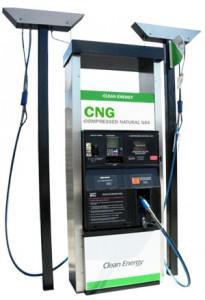 With natural gas prices near historic lows I have been wondering if this will lead to an increase in the number of natural gas powered vehicles on the road. While the numbers have increased, as noted in a recent article, will this lead to a new paradigm in motor vehicle transportation?
With natural gas prices near historic lows I have been wondering if this will lead to an increase in the number of natural gas powered vehicles on the road. While the numbers have increased, as noted in a recent article, will this lead to a new paradigm in motor vehicle transportation?
Natural gas is the cleanest of all the fossil fuels. Composed primarily of methane, the main products of the combustion of natural gas are carbon dioxide and water vapor, the same compounds we exhale when we breathe. As the cleanest-burning fossil fuel, natural gas creates less greenhouse gas emissions than heating oil, or electricity generated from coal.
Natural gas prices have fallen precipitously since 2008 from over $12 per thousand cubic feet to around $2 per thousand cubic feet. This price drop has occurred for a couple of reasons. The main one is the advances in natural gas extraction technology (i.e. fracking) which has greatly increased the natural gas that can be retrieved from U.S. deposits. Another reason is that, unlike oil markets, the natural gas markets are local so natural gas produced in the U.S. generally stays in the United States. This is due to the need for large and expensive shipping and containment facilities as well as gas export licenses, which are hard to obtain, and helps explain why natural gas is $16 per thousand cubic feet in Japan but cheap in the United States. A final reason is that demand for natural gas in the United States has not kept up with supply.
Natural gas comes in two varieties; liquefied natural gas (LNG) and compressed natural gas (CNG). To liquefy natural gas requires that it be stored at -260 degrees Fahrenheit. CNG is stored and distributed in hard containers at a very high pressure 2900–3600 psi, usually in cylindrical or spherical shapes. CNG powered vehicles have been around for decades and currently account for about 2% of all vehicles in the U.S. with almost 60% being public buses. LNG powered vehicles are a relatively new technology and are thus far less prevalent.
So does this mean that we will soon all be driving natural gas powered cars? The short answer is
probably not.
Several major drawbacks exist to using natural gas to power vehicles. First off, natural gas is not as energy dense or efficient as gasoline. For instance, CNG contains nearly 70 percent less energy per gallon equivalent than gasoline or diesel. LNG is more energy dense than CNG but still less so than gasoline. As a result you cannot drive as far on a tank and numerous natural gas filling stations must be built if widespread use of natural gas powered cars is to occur. There would be a significant costs involved to build out this infrastructure. Also, given that natural gas must either be stored at very low temperatures for LNG or very high pressure for CNG, car fuel tanks must have specially constructed to meet those requirements. These special fuel tanks average almost 200 lbs compared to 10 lbs for a normal gasoline tank, adding vehicle weight, reducing cargo space and cutting gas mileage. Furthermore, costs for natural gas powered cars are currently 25% higher than gas-powered cars, though that would probably come down a bit with government subsidies and efficiencies of scale.
All these items point to the fact that a large fleet of natural gas powered cars is not likely even though the price of natural gas may stay relatively low into the near future. I do believe that there will be an increased use of LNG and CNG powered commercial and municipal driving fleets and buses that are used for limited driving distances and have access to centralized natural gas refueling stations. It may be that the natural gas share gain in transportation will not necessarily be reflected in an increased number of CNG or LNG fueled vehicles, but will rather be seen in producing lower-cost electricity that supports the electric vehicle fleet.
Photo Source: cng-times.com

